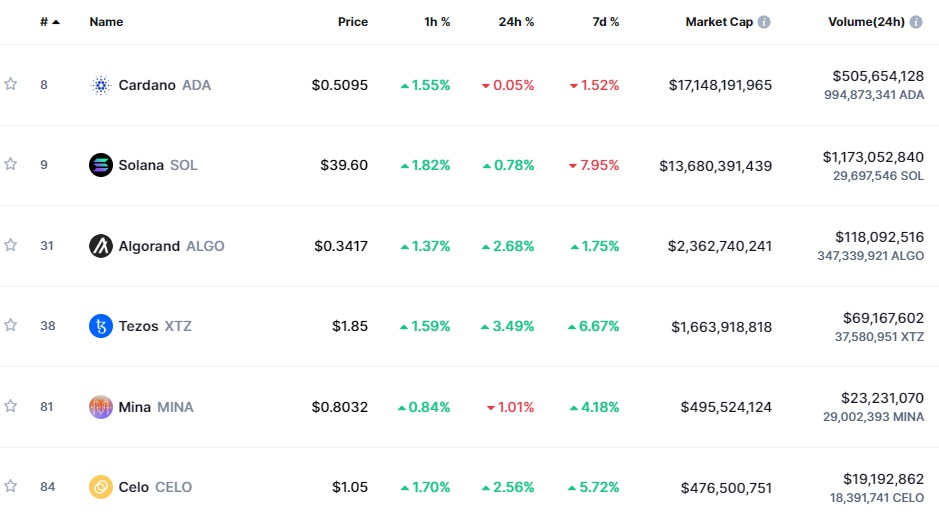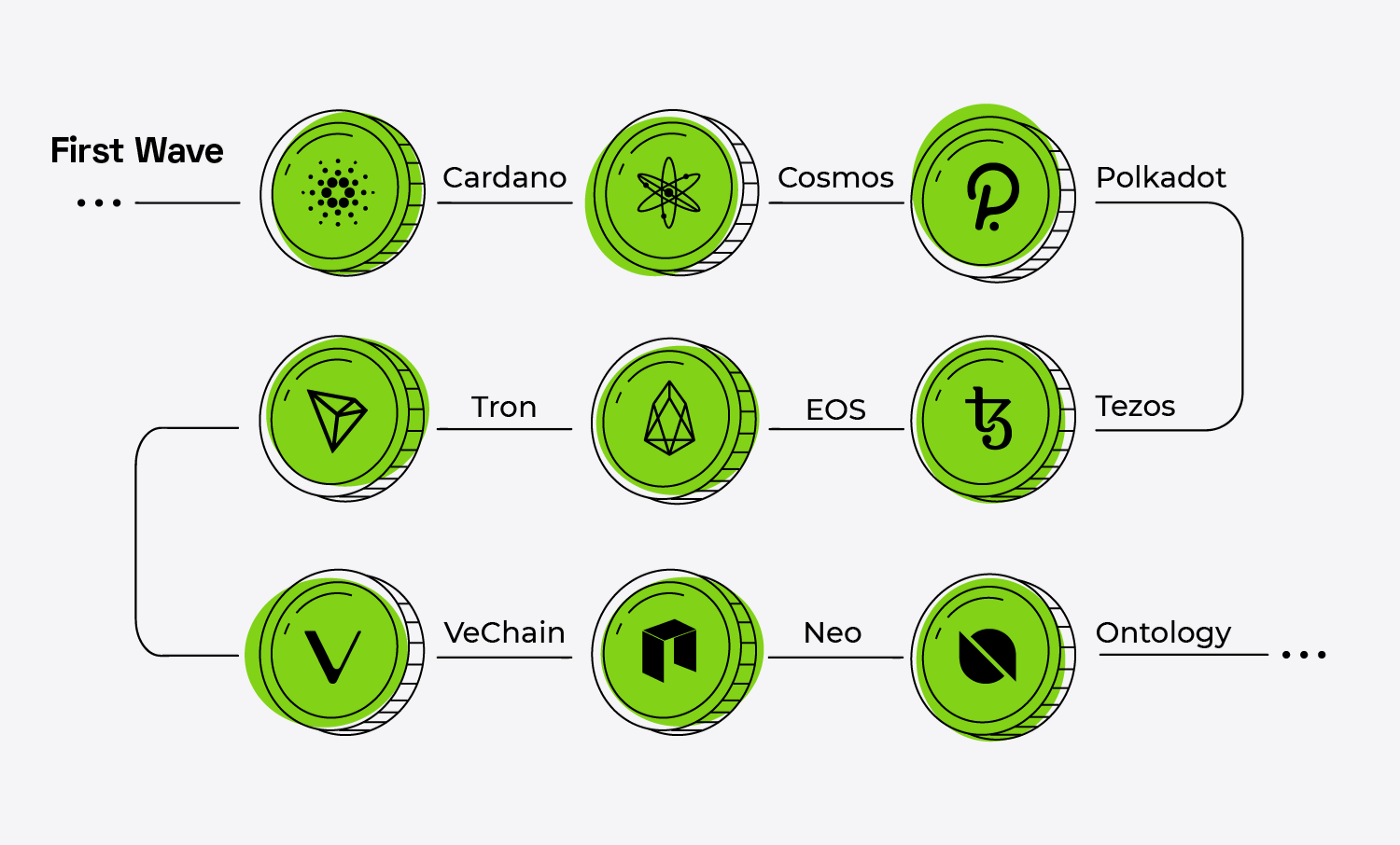What Is Proof of Stake, How It Works and its Pros & Cons
Key Takeaways:
- Proof of Stake (PoS) is a consensus algorithm used in blockchain networks where validators are chosen to create and validate new blocks based on the number of coins or tokens they hold and “stake” as collateral
- Therefore, staking is a process of securing the network and maintaining the blockchain's integrity.
- Node operators that are selected to validate transactions are rewarded with additional crypto for their contribution.
TABLE OF CONTENTS
What Is Proof Of Stake?
Proof of Stake (PoS) is a consensus mechanism to complete transactions by randomly selecting a user to validate new blocks. These users must be running a “node” on the network with a certain amount of cryptocurrency locked up in it. Node operators chosen to validate transactions are rewarded with additional crypto as an incentive. The protocol builds upon the technology ushered in by Bitcoin. Instead of using mining – high-powered computers to solve complex algorithms, PoS networks require validators to hold and stake tokens.
How Does Proof Of Stake Work?
Proof of Stake is a form of adding new blocks to the chain, which is how transactions are verified and documented on the blockchain. Cryptocurrency is inherently decentralized, so there’s no authority to protect the economy from double-spending or fraud. Instead, this role is delegated to a vast network of computers running multiple servers (validator nodes) that form the blockchain. Validator nodes are the key to PoS’ success. These nodes are created by cryptocurrency holders locking up their coins in a smart contract on the network. This process is known as cryptocurrency staking. While the coins are staked, they cannot be traded or spent.
For new blocks on the chain to be verified, PoS protocols randomly assign multiple nodes to validate the information. If the information is accurate, the nodes will confirm the transaction and receive additional cryptocurrency as a reward. Suppose the information is inaccurate or harmful to the network but still gets verified. The validator node is responsible and will lose a portion of its staked tokens in what’s known as a slashing penalty. This helps dissuade malicious activity on a blockchain.
The exact process for each PoS protocol is different. For example, Ethereum will use “shards” to validate cryptocurrency transactions. Each time a new block is proposed, a validator will verify multiple transactions and add them to a shard. This shard will then need to be confirmed by 128 other validators. If more than two-thirds of the 128 accept the new block, the network will finalize the process. Ethereum’s PoS mechanism may sound complex, but ETH transactions are usually completed within 12 seconds. On some other blockchains like Solana, it’s even quicker to validate cryptocurrency transactions.
Introduction To Staking – Explained
Staking is the act of locking up a certain amount of tokens within a node to help make the blockchain secure. Different protocols require different amounts of tokens to run a node. For example, an Ethereum validator node must set aside 32 ETH. For individuals that hold less than 32ETH, they will need to find a platform that accepts ETH staking. Whereas the Cardano network doesn’t have a minimum ADA requirement.

In general, there are two types of staking in PoS consensus mechanisms.
- Validator Staking. Validator stakers run a “full node” on a blockchain. If validators are selected to verify a transaction, they will receive the full block reward. Proof of Stake protocols vary in how they choose validators, but for the most part it depends on the amount of staked tokens and uptime. For example, a validator with 100 ETH staked is more likely to be chosen to approve a new block than one with 32 ETH staked.
- Delegator Staking. Not everyone has the means, technological know-how or time to run a full node. As of writing this article, operating as an Ethereum validator would cost upwards of $50,000 USD in ETH. So, protocols have developed staking pools where those with lower capital can lend their digital currencies to validators. They will then receive a proportional amount of the block reward, minus a fee taken by the validator.
For a full guide on how to stake cryptocurrency, read this article next which explains the best ways for beginners to stake tokens and where earn rewards.
What Cryptocurrencies Use Proof Of Stake?
There are a large number of digital currencies that use the Proof of Stake consensus mechanism as a base. Some use a hybrid mechanism (such as Proof of Stake/Proof of Work or Proof of History/Proof of Stake), whereas others use newer concepts such as delegated Proof of Stake (dPoS). Examples of prominent blockchains that utilize Proof of Stake include:
- Ethereum
- Binance Smart Chain (Proof of Staked Authority)
- Cardano
- Solana (Proof of Stake/Proof of History)
- Polkadot (Nominated Proof of Stake)
- Cosmos
- Tron (delegated Proof of Stake)
- EOS (delegated Proof of Stake)
The most popular staking coins by market cap at the time of writing are shown below with Cardano and Solana networks with the largest share of the crypto market.

Proof Of Stake Pros & Cons
| Proof-of-stake Pros: | Proof-of-stake Cons: |
|---|---|
| Much lower impact on the environment – reported as being 99% more energy efficient than mining protocols | Can be more difficult to decentralize the blockchain due to validators being chosen based on stake size |
| Staking is easy and offers competitive rewards rates of over 5% | Arguably less secure than other consensus mechanisms |
| Scalable and has very fast block times (transaction speeds) | Doesn’t have the same exposure to mass volume that Proof of Work has |
Is Proof of Stake Safe?
Proof of Stake has been around for a while but is yet to be exposed to the same volume and financial responsibility as PoW blockchains like Bitcoin. Due to this, some critics are wary of PoS’ viability in protecting users against malicious behavior. There have been recent examples of recent hacking incidents that question the safety of PoS networks such as Axie Infinity’s Ronin blockchain bridge which was hacked in March 2022 to the tune of $615m USD. Moreover, In June 2022, the effective Proof of Stake blockchain Harmony was hacked, losing $100m USD.
What Are The Common Security Risks with PoS?
1. Theft
Theft with PoW protocols isn’t as much of a long-term issue. Once a hacker steals Bitcoin, they cannot use that BTC to accrue more Bitcoin from the network. Sure, they might be able to lend it to an earning protocol, but the BTC rewards they receive are already in circulation and have no bearing on the blockchain’s operation.
Conversely, stolen Proof of Stake tokens could then be re-staked into the protocol. Not only would this generate more tokens for the hacker, but it would also give them a greater stake in the network’s operation. Over time, if enough tokens were stolen and accumulated, they could theoretically launch a 51% attack on the blockchain.
2. 51% attack
Another common concern with Proof of Stake security is known as a 51% attack. This type of hack has occurred on Proof of Work protocols too, but experts believe it could be easier to execute on PoS. 51% attacks happen when a high-capital individual manages to own a majority of a staked cryptocurrency and validate fake, financially beneficial transactions. However, this issue may be overstated. For starters, owning 51% of a prominent PoS token would likely require millions of dollars. Then, consider that blockchains like Solana, Cosmos and Polkadot have 50+% of their supply already locked up in delegator or validator nodes. Together, this makes a 51% attack unlikely to occur on most major PoS networks.
3. Centralization
Centralization of PoS protocols is a frequently-touted dilemma. Because participation in staking is simpler and less competitive than mining, it’s easier for high-capital investors to accumulate control. Early adopters or those with more tokens typically have a greater say in the PoS network’s direction. If exploited, some Proof of Stake blockchains will begin to resemble oligarchies more than they do democracies.
However, most well-developed PoS networks have contingencies in place to prevent over-centralization. Centralization may seem like a pressing issue, but solid governance infrastructure and an active community go a long way to keeping PoS decentralization intact.
Differences Between Proof Of Stake And Proof Of Work
Proof of Stake emerged as a sustainable alternative to Proof of Work consensus protocols. This is the first key difference between the two mechanisms – PoS requires substantially less computational power. Proof of Work protocols (such as mining Bitcoin) requires high-powered processing units to solve “hash codes”. This can only be done by algorithmic trial and error, so mining computers must be left on close to 24/7 at full processing capacity. On the other hand, validating transactions on a PoS blockchain can be done with pretty much any computer. Validator nodes must run software at essentially 100% uptime, but the power consumed from this application is substantially less than Bitcoin mining software.
Another major benefit of Proof of Stake is increased throughput and block time. For example, Bitcoin’s average block time is 10 minutes. This means that sending BTC on the Bitcoin network can be rather slow. Therefore, Bitcoin is quite limited in hosting applications. PoS models regularly have 30 seconds or less block times, giving them enhanced scalability and transaction speeds compared to PoW blockchains.
However, the differences between the two are not all positive for Proof of stake. Some experts suggest Proof of Work promotes better decentralization due to the large number of computers needed to solve hash codes. There are often more participants in mining a cryptocurrency than viable validators on a PoS network. Mining Bitcoin and other digital currencies have a much higher barrier for entry than staking. While this is of financial benefit to Proof of Stake participants, it also means they can be easier to infiltrate and attack. For a full comparison of staking versus mining, read this article next that lists the major similarities and differences.
The History Of Proof Of Stake
An early form of PoS was developed in 2012 by Sunny King and Scott Nadal for their cryptocurrency, Peercoin (PPC). The premise of PPC was to focus on Bitcoin’s unsustainable energy consumption, which by the late 2010s was as high as the entire country of Malaysia. Peercoin was based on a foundation of Bitcoin’s technology but also implemented rewards for those who held the PPC coin. The more PPC someone owned, the more vital they were to validating transactions. This removed the reliance on mining and cut back on power usage seen in Bitcoin at the time.
As time passed, the necessity of a sustainable model became more vital to the blockchain’s future. When Bitcoin started, it only took a below-average PC to mine new coins. Between 2013-17, the value of BTC jumped dramatically and mining became ultra-competitive. Before long, BTC miners required top-of-the-range computers running 24/7 to earn a few bucks a day. So, developers started work on optimizing the Proof of Stake consensus mechanism.
There were a few attempts in the meantime to revolutionize the blockchain industry – coins like NXT and Blackcoin were introduced using Proof of Stake. However, the protocol didn’t go mainstream until Ethereum (ETH) was released in 2015. Although Ether started out as a Proof of Work blockchain (like Bitcoin), it always intended to move to Proof of Stake.
It was in 2017 that developers created many of the Proof of Stake blockchains popular today. This “first wave” of networks, along with Ethereum, implemented advanced smart contracts and substantially expanded the use case of cryptocurrency. Decentralized applications became more viable as blockchains like Cardano, Cosmos, Tron, Polkadot and Tezos were released.

In 2022, Proof of Stake is almost as popular as Proof of Work. Most new blockchains and cryptocurrencies are built on this model. Ethereum finalizing its transition to the consensus mechanism in 2022-3 will be a landmark moment for PoS, and its future looks bright as a solution to the inefficiencies of mining.
Frequently Asked Questions
Who Invented Proof of Stake?
Proof of Stake was first introduced in 2012 in a whitepaper from developers Sunny King and Scott Nadal.
Is Proof of Stake secure?
Proof of Stake is a safe blockchain network in the same way a cryptocurrency exchange might be safe. There can be no guarantee that an attack or hacking event won’t occur. However, reputable and well-run PoS networks are less likely to be compromised and reduce the risk of loss.
Can You Earn A Living Staking Crypto On A PoS Protocol?
Yes, some people can earn a comfortable income just by staking on a Proof of Stake blockchain. However, there are a lot of factors that will influence this, such as available capital and network competition. Staking coins that offer the highest adjusted yield is an important factor to maximize the return on investment.
Is Proof of Stake better than Proof of Work?
Proof of Stake has some distinct advantages over Proof of Work. Namely, the protocol has substantially less impact on the environment. It is also easier to participate and earn rewards in a Proof of Stake network than mining blockchains like Bitcoin. However, experts have argued that PoW is more secure and decentralized than PoS.
Is Solana Proof of Stake?
Solana uses a unique hybrid consensus mechanism. The blockchain combines Proof of Stake with Proof of History to validate transactions on the network. This enables individuals to stake Solana on-chain and receive SOL tokens as rewards.




